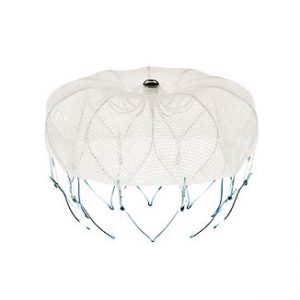The Watchman Device
 In the spirit of treating significant potential risks with minimally invasive solutions, electrophysiologists like Dr. Tordini now often use a clever medical device to seal the left atrial appendage or LAA. This device, known as the Watchman, looks much like a parachute connected to a bio-compatible metal lattice. The Watchman fits snugly over the opening to the LAA and, over time, creates a strong barrier between the LAA and the rest of the left atrium. Doing so seals off blood clots within the LAA permanently.
In the spirit of treating significant potential risks with minimally invasive solutions, electrophysiologists like Dr. Tordini now often use a clever medical device to seal the left atrial appendage or LAA. This device, known as the Watchman, looks much like a parachute connected to a bio-compatible metal lattice. The Watchman fits snugly over the opening to the LAA and, over time, creates a strong barrier between the LAA and the rest of the left atrium. Doing so seals off blood clots within the LAA permanently.
How Is the Watchman Placed?
The Watchman is placed by Dr. Tordini in an electrophysiology or EP lab. This is a special operating room set up for catheter specific procedures. The patient is sedated, and a small incision is made in the arm or the groin. A small sheath, used to guide the catheter, is threaded up to the heart, through a blood vessel, and positioned in front of the LAA. At this point, the Watchman is deployed and fits snugly over the opening to the LAA.
When the body detects a foreign object, it often tries to absorb or isolate it by developing scar tissue around it – and this is exactly the result that we are looking for. Over the course of the next several weeks, the body will develop scar tissue around the Watchman device, creating a strong and often permanent seal that keeps blood clots from the LAA filtered out of the cardiovascular system.
Watchman Procedure Information
Watchman device placement is typically very successful and safe, especially in the hands of an experienced electrophysiologist such as Dr. Tordini. The entire procedure takes less than an hour, not including prep and recovery time. Patients are usually released on the same day or kept at the hospital for one night for observation.
The risks of a Watchman placement are quite low. Most of the risk revolves around the insertion and guidance of the catheter up to the heart. Occasionally, patients may have some pain, blood loss, or infection at the incision site. More rarely, there can be damage to the walls of the blood vessel used to guide the catheter up to the heart. Extremely rarely, patients may experience a cardiovascular event during the procedure. There is also the small possibility that the Watchman device does not properly seal the LAA.
However, the experience and technique of Dr. Tordini help mitigate these risks and ultimately, the procedure is exceptionally successful.
If you are at risk of stroke due to Afib, we encourage you to make an appointment with Dr. Tordini to learn more about your options and the best ways forward. From lifestyle change to curative procedures, we have a wide range of options to handle any arrhythmia – straightforward or complex.